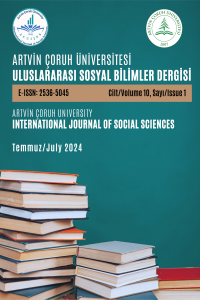Research Article
Aim & Scope
Artvin Coruh University Journal of International Social Sciences publishes scientific, social and human scientific studies at the local, national and international level to contribute to the knowledge of the social sciences.
Author Guidelines
YAYIM VE YAZIM KURALLARI
Sayfa Yapısı ,Yazı Biçimi, Paragraf Yapısı ve Satır Aralığı
Yazar Bilgisi
Başlıklar (Bölüm Başlığı, Ana ve Alt Başlıklar)
Extended Abstract
Etik Beyanı ( Times New Roman, 9 punto, tek satır aralığı, önce 0 nk ve sonra 0 nk)
Kaynak Gösterimi İçin Örnekler (APA 7)
Metin İçi Atıf Gösterimi
İki yazarlı kaynaklara atıf : (Doğan ve Uzun, 2020: 17).
Üç yazarlı kaynaklara ilk atıf : (Engin, Uzun ve Çetin, 2010: 9).
Üç yazarlı kaynakları takip eden atıf : (Engin, vd., 2010: 7).
Üçten fazla yazarlı kaynaklara atıf : (Çelik vd., 2023: 15).
İkincil kaynaklar/Aktaran : (Özbek, 2020; akt. Uzun, 2022: 11).
Yabancı iki yazarlı kaynaklarda : (Svendsen & Løber, 2020: 15).
Tüzel yazarlı çalışmalar
• İlk atıf : (Türkiye Bilimsel ve Teknolojik Araştırma Kurumu [TÜBİTAK], 2013: 19).• İkinci ve sonraki atıflar : (TÜBİTAK, 2013: 19).
KAYNAKÇA LİSTESİNİN HAZIRLANMASI
Çalışmada yararlanılan her türlü kaynak, kaynakça bölümünde gösterilmelidir. Kullanılan kaynaklar dergi veya makale sınıflandırması yapılmadan, yazar soyadına göre alfabetik olarak sıraya koyularak, kaynakça girintisi “özel asılı ve değer 1 cm” olarak ayarlanmalıdır. Kaynakça Times New Roman 10 punto ile tek satır aralığı ile yazılmalıdır. Kaynakçanın düzenlenmesinde APA 7.0 formatı kullanılmalıdır.
Dergiler:
Makale isminin yalnızca ilk harfi büyük, diğer harfleri küçük ve düz yazılarak sonuna nokta koyulmalıdır. Dergi adının tüm kelimelerinin ilk harfleri büyük ve italik şekilde yazılmalı ve sonuna virgül koyulmalıdır. Dergi cilt sayısı italik ancak sayı no parantez içinde düz olmalıdır.
- Yazar Soyadı, A. (Yıl). Çalışmanın başlığı. Dergi Adı, cilt(no), 277-294.
Al-Ansari, Y., Altalib, M., & Sardoh, M. (2013). Technology orientation, innovation and business performance: a study of dubai smes. The International Technology Management Review, 3(1), 1-11. https://doi.org/10.1016/0090-2616(90)90061-S
Bass, B. M. (1990). From transactional to transformational leadership: Learning to share the vision. Organizational Dynamics, 18(3), 19-31. https://doi.org/10.1016/0090-2616(90)90061-S
Grady, J. S., Her, M., Moreno, G., Perez, C., & Yelinek, J. (2019). Emotions in storybooks: A comparison of storybooks that represent ethnic and racial groups in the United States. Psychology of Popular Media Culture, 8(3), 207–217. https://doi.org/10.1037/ppm0000185
Kitaplar :
Yazar soyadı, adının baş harfinden sonra nokta koyulmalı ve yıl parantez içerisinde yazılmalıdır. Kitap ismi italik ve küçük harflerle verilmelidir. Kitap isminin başında ve sonunda nokta olmalı ardından yayınevi düz ve büyük harfle başlayacak şekilde verilmelidir.
- Berberoğlu, M. (2022). Kitap adı. (1. Baskı). Gazi Kitabevi.
Avolio, B. J., & Bass, B. M. (2002). Developing potential across a full range of leadership: cases on transactional and transformational leadership. Lawrence Erlbaum Associates.
Bass, B. M. (1985). Leadership and performance beyond expectations. Free Press.
Ersoy, M. (2019). Katılım bankalarında kontrol (1. Baskı). Yalın Yayıncılık.
Jeckson , L. M. (2019). The psychology of prejudice: From attitudes to social action (2nd ed.). American Psychological Association.
Editörlü Kitaplar:
Editörlü Kitap Bölüm:
Yazarın soyadı, yazarın adının baş harfi. (Yıl). Kitap bölümünün adının yalnızca ilk harfi büyük, diğerleri küçük ve düz olarak yazılmalı, sonuna nokta koyulmalıdır. Editörün adının baş harfi. Editörün soyadı (Ed.), Kitabın adının ilk harfi büyük, diğerleri küçük ve italik olarak yazılmalı (Baskı sayısı, Sayfa aralığı) içinde. Yayınevi.
Palmer, F. (2007). Treaty principles and Maori sport: Contemporary issues. In C. Collins & S. Jackson (Eds.), Sport in Aotearoa/New Zealand society (307-334). South Melbourne.
Çeviri Kitaplar:
Yalom, I. D. (1998). Kısa süreli grup terapileri: İlkeler ve teknikler (N. H. Şahin, Çev.). Türk Psikologlar Derneği Yayınları. (Orijinal çalışma basım tarihi 1983).
Tezler:
Yazarın soyadı, yazarın adının baş harfi. (Yıl). Tez çalışmasının adının yalnızca ilk harfi büyük, diğerleri küçük ve italik olarak yazılmalı, köşeli parantez içerisinde tez türünün il harfi büyük diğerleri küçük yazılmalı ve sonuna nokta koyulmalıdır. Tez çalışmasının yapıldığı üniversite adının ilk harfleri büyük yazılmalıdır.
Berberoğlu, M. (2014). Çin'den yapılan ithalatın Türkiye'deki firmaların performansına etkisi: İSO 1000 araştırması [Yayımlanmamış doktora tezi ]. Karadeniz Teknik Üniversitesi.
Harris, L. (2014). Instructional leadership perceptions and practices of elementary school leaders [Unpublished doctoral dissertation]. University of Virginia.
Bilimsel Toplantı ve Sempozyum Sempozyum/Panel:
Yazarın soyadı, Adının baş harfi. (Yıl, Ay, Gün). Sunum başlığının yalnızca ilk harfi büyük diğerleri küçük ve italik yazılmalıdır.[Konferans Sunumu/Poster Sunum/Tam Metin Bildiri ]. Konferans adı, Sempozyumun Gerçekleştiği Şehir, Ülke, url.
Berberoğlu, M. ve Kızılkan, Ç. (2022, Haziran, 9-11). Lisanslı depoculuk ve Türkiye ürün ihtisas borsası (turib) sistemlerinin bölgeye etkisi. Artvin Çoruh University International Congress On Ecology, Economy, And Regional Development. Artvin, Türkiye, https://www.artvin.edu.tr/uploads/ecosus.artvin.edu.tr/userfiles/files/abstract%20book-ecosus.pdf.
İnternet Kaynakları:
Cossin, D., & Caballero, J. (2013). Transformational leadership: background literature review. IMD. https://www.imd.org/uupload/IMD.WebSite/BoardCenter/Web/213/Literature%20Revie w_Transformational%20Leadership.pdf adresinden 22.02.2020 tarihinde alınmıştır.
Toner, K. (2020, September 24). When Covid-19 hit, he turned his newspaper route into a lifeline for senior citizens. CNN. https://www.cnn.com/2020/06/04/us/coronavirus-newspaper-deliveryman-groceries-senior-citizens-cnnheroes-trnd/index.html
Medya Kaynakları (Film, Video, podcast vb.):
Yazar/Yapımcı/Sanatçı Soyadı, Adının baş harfi. (Yıl). Konuşma/şarkı/bölüm adı [Sesli veya Video]. İnternet adresi.
Türkçe Anadol, R. (2020, Temmuz). Makine zekası çağında sanat [Video]. TED Konferansları. https://www.ted.com/talks/refik_anadol_art_in_the_age_of_machine_intelligence?language=tr#t931
Sosyal Medya Kaynakları:
Yazar Soyadı, Adının baş harfi [kullanıcı adı]. (Yıl, gün, ay). Postun ilk 20 kelimesi [Tanımlama]. Site adı. İnternet adresi.
Alper, S. [@SinanAlper_]. (2020, 2 Eylül). Gerçekten de, istatistiğin ve onu kullanan bilim alanlarının temelde amacı aynıdır: Henüz yaşanmamış şeyleri tahmin edebilmek [Tweet]. Twitter. https://twitter.com/SinanAlper_/status/13012109 33335916547
Film/Kitap İncelemesi:
İnceleyenin Soyadı, Adının baş harfi. (Yıl). İncelemenin başlığı [yazar/yapımcı adının baş harfi, Soyadı tarafından yazılan/yönetilen İncelenen kitabın/filmin adı isimli kitabın/filmin incelenmesi]. Yayımlanan derginin adı, cilt(no), sayfa aralığı veya Gazetenin adı veya Yayımlanan internet sitesi.
Türkçe Yavaş Bozkurt, A. (2013). Kitap incelemesi [R. Bucher tarafından yazılan Diversity consciousness başlıklı kitabın incelenmesi]. Sakarya University Journal of Education, 3(3), 137-138. https://dergipark.org.tr/tr/download/articlefile/192324
Fleming, V. (Director). (1939). Gone with the wind [Film]. Selznick International Pictures; Metro-Goldwyn-Mayer.
Sözlükler:
American Psychological Association. (2015). Mood induction. In APA dictionary of psychology (2nd ed., p.667).
Türk Dil Kurumu. Türkçe kavramı. Türk Dil Kurumu Sözlüğü. https://sozluk.gov.tr/ adresinden 20.02.2023 tarihinde alınmıştır.
Bilgin, N. (2003). Sosyal psikoloji sözlüğü: Kavramlar, yaklaşımlar. Bağlam Yayıncılık.
Diğer Kaynaklar için:
Türkiye Bankalar Birliği (2007, Mayıs). Küçük ve orta büyüklükteki işletmelerin mali sektöre olan borçlarının yeniden yapılandırılması programı bilgilendirme notu
DPT (2000). İklim değişikliği özel ihtisas komisyonu raporu. Sekizinci beş yıllık kalkınma planı, Ankara.
Sudarsanam, S., Sorwar, G., & Marr, B. (2003, October). Valuation of intellectual capital and real option models. PMA Intellectual Capital Symposium.
Yılmaz, B. (2003). Turkey’s competitiveness in the European Union: A Comparison with five candidate countries – Bulgaria, The Czech Republic, Hungary, Poland, Romania and the EU15. Ezoneplus Working Paper No. 12.
NOT: Diğer kaynak türleri ile ilgili ayrıntılı bilgiye APA 7 resmi sitesinden (https://apastyle.apa.org/style-grammar-guidelines/references/examples/) ulaşabilirsiniz.
Ethical Principles and Publication Policy
Artvin Coruh University International Journal of Social Sciences (ISSN: 2458-8385) is an academic journal that complies with international standards. The journal has published scientific articles in print and electronic since 2015, and only in electronic platforms with the 2017 December issue.) It shares national and international studies in the fields based on social and human sciences (involving history, sociology, philosophy, literature, philology, geography, sports management, recreation, archeology, art history, law, political science, international relations, economics, business, psychology, fine arts, etc.) with open access logic.
Submitted articles are scanned by a double-blind peer-review method and published electronically with free access. Below are the ethical responsibilities, roles, and duties of the authors, journal editor, reviewers, and publisher. The ethical principles and rules below have been prepared following the "Committee on Publication Ethics - COPE " guidelines (https://publicationethics.org/)."
In addition, knowledge concerning the situations regarded as plagiarism and unethical behaviors was given in Artvin Coruh University International Journal of Social Sciences.
Ethical Responsibilities of Authors
• The articles submitted to Artvin Çoruh University International Journal of Social Sciences are based on social and human sciences; history, sociology, philosophy, literature, philology, geography, sports management, recreation, archeology, art history, law, political science, international relations, economics, business, psychology, and fine arts, etc. There should be original studies in the fields.• All sources employed in articles (authors, online pages, personal interviews, etc.) should be documented accurately and adequately.
• It should be mentioned that the articles sent to the journal were not sent to another journal, and the Copyright Form should be filled out.
• The author(s) should present a plagiarism report concerning their article. If the study needs ethics committee approval, they should accept it from the appropriate units and send it to our journal. Suppose the article is a study that does not demand ethics committee approval. In that case, it should fill in the appropriate form on our journal page and upload this file on the ethics committee approval download page.
• Persons who do not contribute intellectually to the article should not be mentioned as authors.
• Conflicts of interest regarding the submitted article should be reported, and the reason should be clarified.
• Authors may be demanded to submit raw data regarding their work to the editorial board while in the peer review process, in which case the authors are supposed to share their raw data with the editorial board.
• Authors are obliged to hold the data of a published article for five years.
• When authors notice an error in their work, they should declare the editor and the editorial board and cooperate in the correction or withdrawal process.
Ethical Responsibilities of Reviewers
Double-blind refereeing; means keeping the authors confidential from the referees and the referees from the authors to ensure an impartial, objective, and independent evaluation process. Double-blind peer-review evaluates all articles submitted to Artvin Coruh University International Journal of Social Sciences. Articles are sent to the referees from the journal management system for evaluation.The ethical responsibilities and roles of the referees of Artvin Coruh University International Journal of Social Sciences are as follows:
• Referees are only demanded to referee articles related to their field of expertise.
• Reviewers are expected to agree to referee articles that do not have conflicts of interest. When reviewers recognize any conflict of interest, they should inform the editor and reject to referee the article.
• Reviewers should assess the articles impartially and objectively.
• Referees are demanded to fill in the Referee Evaluation Form for the articles they evaluate.
• In this form, the referees are required to state their decision on whether the article they are evaluating is publishable or not and the reasons for their decision.
• The style used by the referees in their suggestions should be polite, respectful, and scientific. Referees should detour offensive, disrespectful, and subjective personal comments. When it is determined that the referees make such non-scientific comments, they can be contacted by the editor or the editorial board to review and correct their comments.
• The referees must complete their evaluations within the given time and are expected to comply with ethical responsibilities.
Ethical Responsibilities of Editors
General duties and responsibilities
Relationships with Reviewers
Relationships with Authors
Relationships with the Editorial Board
Relationships with the Journal's Owner and Publisher
• Artvin Coruh University publishes the Artvin Coruh University International Journal of Social Sciences. The publisher's ethical responsibilities are as follows:• The publisher accepts that the decision maker and the refereeing process are the editor's responsibility in publishing an article in the International Journal of Social Sciences of Artvin Coruh University.
• The publisher furnishes open, electronic, and free access to the journal on the journal's web page.
Unethical Behavior and Plagiarism
Some unethical behaviors are detailed below:
• Noting those who did not contribute intellectually to the study as authors.
• Not specifying the people who contributed intellectually to the study as authors.
• Failure to exhibit if the article was produced from the author's master's/doctoral thesis or a project.
• Slicing that is, publishing more than one article from a single study.
• Not reporting conflicts of interest regarding submitted articles.
• Deciphering the double-blind reviewing process.
Price Policy
Artvin Coruh University International Journal of Social Sciences (ACUSBD) does not charge a fee at any stage of submission, evaluation and publication of articles. No article processing fee or submission fee is paid for manuscripts submitted to the journal. All expenses of ACUSBD are covered by Artvin Coruh University.
Indexes
Journal Boards
Owner

Editor in Chief


 Web
Web
Lisans Eğitimine Karadeniz Teknik Üniversitesi, Ünye İktisadi ve İdari Bilimler Fakültesine 2000 yılında işletme bölümünde başlayan Berberoğlu 2004 yılında bu fakülteden mezun olmuştur. Aynı Üniversitenin Sosyal Bilimler Enstitüsü, işletme Ana Bilim Dalında sırasıyla yüksek lisans ve doktora eğitimini tamamlamıştır. 2009 Yılında Artvin Çoruh Üniversitesinde göreve başlayan Berberoğlu halen bu üniversitede doçent doktor olarak görev yapmaktadır. Berberoğlu Evli ve iki çocuk Babasıdır.
Assistant Editors


Field Editors










Secretary

Language Editor

İngilizce



Publishing / Editorial Board






Artvin Coruh University International Journal of Social Sciences
ACUSBD is licensed under the Creative Commons Attribution-NonCommercial 4.0 International License (CC BY-NC).



